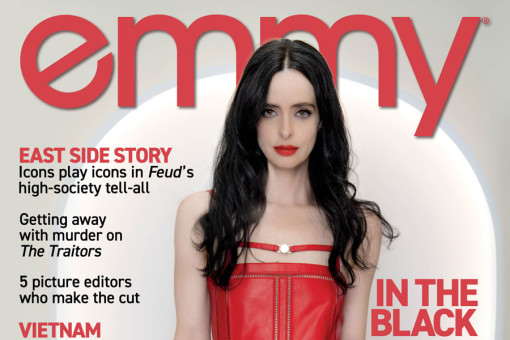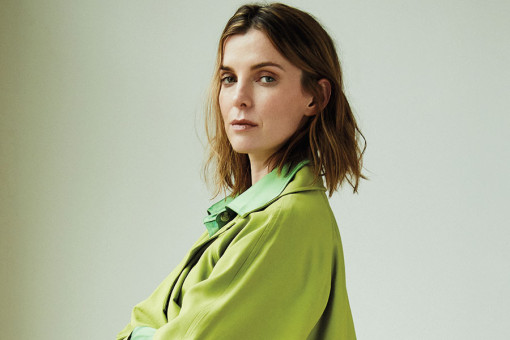Back in December 2018, Zoe Saldaña and her husband, Marco Perego, were dining at an L.A. sushi restaurant with four other couples, including Reese Witherspoon and her husband, CAA agent Jim Toth. Saldaña recalls how intently Witherspoon focused on Saldaña's and Perego's trilingual chat. "We switch from Spanish to English to Italian," says Saldaña, who is of Dominican and Puerto Rican descent and whose husband was born and raised in Italy's Lombardy region. "We're very passionate, almost a bit dramatic in how we communicate."
A few days later, Saldaña received a text from Witherspoon and discovered that she hadn't just been staring. She'd been thinking about a limited-series project: Tembi Locke's forthcoming book, From Scratch: A Memoir of Love, Sicily, and Finding Home. The author's younger sister, writer-producer Attica Locke, had recently presented the book to Lauren Neustadter, president of film and television at Witherspoon's production company, Hello Sunshine. Witherspoon had already earmarked From Scratch as a Reese's Book Club pick — now she was casting in her head.
"She said, 'I shouldn't be telling you this.... I should probably wait,'" Saldaña recalls. "'But I think you're so right for the part.'"
Watch our Under the Cover Interview with Zoe Saldaña.
Initially, Saldaña was hesitant. "I come from a culture that is very superstitious," she explains. Then, the manuscript of From Scratch arrived. In it, Locke chronicles how as an exchange student in Florence, she met and fell in love with a Sicilian-born chef, Rosario "Saro" Gullo, whom she married, despite the objections of his family. The couple's happiness, which includes an adopted infant daughter, is upended when Gullo is diagnosed with a rare cancer and subsequently dies.
What Saldaña saw was a romantic, grief-streaked narrative made original by its shift in perspective. "Stories usually focus on the person who is fighting for their life," she points out, "not on the caretaker, the one right beside them fighting for their life as well."
She signed on to star and executive-produce, along with her production company, Cinestar Pictures, which she runs with her sisters, Mariel and Cisely. The trio then joined forces with Attica and Tembi Locke.
Going alone into a cavernous conference room to pitch a show to a phalanx of executives can be intimidating. As a united front, though, the Saldaña and Locke siblings entered these scenarios controlling the narrative. "Five sisters, all women of color, walking into this room, like, we're going to tell this story about a great epic love that is international, cross-cultural, touches motherhood, grief, love, loss, the whole thing," Tembi Locke says, describing the scene. "It was like, 'This is who we are. Want to come play with us?'"
Attica adds: "We brought a party into every room," and they never let their buoyant energy distract from their collective mission. "One of the things Zoe locked in on really early was that women of color don't get a lot of these self-discovery stories. She was very protective of that. That's part of what drew her to the project."
It's easy to understand why Tembi Locke's journey struck such an emotional chord in Saldaña. Until age nine, she was a typical kid from Queens, New York — the middle daughter of Aridio Saldaña and Asalia Nazario, who ran a small clothing store with her seamstress grandmother. Dad played multiple musical instruments and loved to dance with his wife.
Then one day in 1987, Zoe's grandma gathered the sisters and told them their father had been killed in a car accident. Their world as they knew it was gone. Saldaña says: "I remember her drinking coffee and saying, 'We're going to get through this. Papa wants us to get through this. But please understand this part of life: death came knocking and took one of us.'"
Disbelief, sorrow, pain — her own deeply submerged feelings came roaring back as she read Locke's book. "It was all of those things that Tembi wrote about, but [viewed] through a childlike lens. Losing our hero, the strongest person in the room, who walked on water, and then seeing how our gorgeous, strong mom just fell apart and couldn't get out of bed to take us to school."
Eventually, the Saldaña sisters were sent to live with their grandparents in the Dominican Republic. For an American kid, getting used to the Caribbean amounted to an endless series of adjustments. "There's no winter, no Santa Claus, no grapes or apples — it's mango and guavas," Saldaña says. "Everything was always new and changing, changing, changing. These sound like small things, but they add up in a day. It was hard."
Also new: Saldaña began studying ballet, and she credits that training for the turning point that would come later, during her acting career: her motion-capture performance as the blue-skinned, Na'vi-speaking and physically graceful Neytiri in Avatar, James Cameron's 2009 sci-fi blockbuster. (She reprises the role in its sequel, Avatar: The Way of Water, later this year.) Saldaña also appeared as Lieutenant Uhura in Star Trek and Gamora in Marvel's Guardians of the Galaxy films. But her siblings maintain that their mother is responsible for this pillar of their sister's career.
"Sci-fi is the only thing Mom watches," Mariel says, adding that not only did she, Cisely and Zoe devour each of Octavia E. Butler's page-turners, their mom's idea of a bedtime story was Frank Herbert's epic novel Dune. "I'm not sure it was age-appropriate, but we all enjoyed it."
But a case can be made that Saldaña's time in the Dominican Republic shaped her understanding of building a life in a new world. "I've always felt like an alien in my own skin," the actress says. "It's like I'm on the outside looking in, and I really started to feel it after we lost our dad."
She didn't discover acting until she was back in the U.S., a sixteen-year-old joining FACES, a small theater troupe for teens in Brooklyn. A few years later, she booked the season-nine finale of Law & Order. Then came her film debut in 2002's Crossroads, in which she played a popular girl who takes a cross-country road trip with two high-school friends. Though the film, written by Shonda Rhimes, was shredded by critics, most of the wrath was directed at her perky costar, Britney Spears.
A year later, Saldaña appeared in a summer tentpole, the flamboyant high-seas-adventure Pirates of the Caribbean: The Curse of the Black Pearl. After that, there was no turning back.
It wasn't always easy. One of her long-held secrets was that, because she grew up in a Spanish-speaking household — with six of those years in the Dominican Republic — she processes scripts at a different pace than those whose first language is English.
"I'm a daughter of immigrants," she says. "I grew up in a foreign country. Spanish is my first language. When I'm reading something, I sometimes have to read it twice or thrice to understand it. I've realized that a lot of people in my career weren't aware of that because I was unable to communicate it."
But eventually she had enough industry sway to consider developing her own projects — and it made sense that she and her sisters would gravitate toward television.
"Zoe always says that the TV was our babysitter," Mariel says, recalling that while glued to Punky Brewster and Who's the Boss? they'd fantasize about the day they could create shows that offered a greater personal connection.
"The thing we missed was representation," Cisely says, "seeing people that looked like us on TV. We wanted to portray the world as it really is. For some reason, we just knew [producing television shows] is where we were going to end up. We always knew we'd have a production company. We just didn't know the name for it back then."
Read this article in the digital edition of emmy.
To read the rest of the story, pick up a copy of emmy magazine HERE.
This article originally appeared in its entirety in emmy magazine, Issue No. 8, under the title, "Her Sisters' Keeper."














